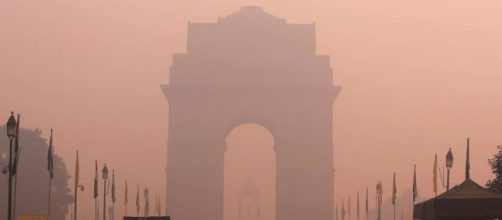A public health emergency has been declared in Delhi after doctors have compared current Smog levels to smoking at least 50 cigarettes in a single day, meaning that the smog levels in some areas were of PM 2.5, up to 40 times higher than the World Health Organisation's limit.
How has it been caused?
Dubbed "The Great Smog of Delhi," there are two main factors which have caused this - the first being the crop burning in the neighbouring states of Punjab, Haryana and Uttar Pradesh. It is estimated that around 35 million tonnes worth of crops has been set on fire in these three states, leading to winds carrying over pollutants and dust particles which have become stuck in the air to Delhi.
Furthermore, as the winter weather begins, the particles are unable to escape from the atmosphere due to stagnant winds.
The second reason is the pollution which is caused by traffic in the national capital. A study revealed that 52% of particles in the city's air was from dust kicked up by the thousands of cars on the city's roads, partly caused by the overpopulation of the region.
What are the effects of smog?
According to the Environmental Protection Agency (EPA), it can be dangerous to breathe in too much smog as exposure can lead to several different types of health problems as a result of a pollutant called ozone which is contained within. Examples of health issues include coughing and throat or chest irritation, leading to asthma symptoms, difficulty breathing and lung damage.
It can also aggravate current health problems such as emphysema, chronic bronchitis and eye irritation, as well as a reduced resistance to colds, cases of flu and infections - particularly lung infections.
The ozone contained within the smog is also harmful to plant growth and can cause widespread damage to crops and forests.
Meanwhile, social media footage is showing an increasing number of road accidents due to the prevailing fog.
Arvind Kumar, a lung surgeon at the Sir Ganga Ram hospital in north Delhi pointed out that “In the last two years, half my lung cancer patients have been non-smokers” and it has also been noted in a study released in the Journal of Indian Pediatrics that children in Delhi have smaller lungs and a reduced rate of lung growth compared to children in developed countries such as America.
A recent study published in the Lancet has found roughly 2.5 million Indians die from pollution every year, the highest number in the world.
What has been done so far?
In the first instance, India's Supreme Court banned the sale of fireworks ahead of the festival of Diwali in an attempt to curb air pollution in the notoriously smoggy city although many chose to dodge the ban.
Over 6000 schools were closed temporarily and a recent plan to use helicopters to sprinkle water over the city to minimise the haziness has backfired after flights were unable to take off due to poor visibility. USA-based United Airlines has cancelled all flights to New Delhi until conditions improve.
A more controversial move has been car rationing whereby private cars with even and odd number plates will only be allowed on the roads on alternate days from 13 to 17 November which some users have labelled a "tokenistic" effort to curb pollution.
Meanwhile, India's environmental watchdog described the plan as "a farce".
Responses from officials have also been criticised as Union Environment Minister Dr Harsh Vardhan said that "no death certificate has the cause of death as pollution." It has also recently emerged that Amarinder Singh, Punjab Chief Minister, has twice refused to meet his Delhi counterpart Arvind Kejriwal saying: “I fail to understand why the Delhi CM is trying to force his hand, knowing full well that any such discussion would be meaningless and futile” He has instead asked for the central government to coordinate a response.


